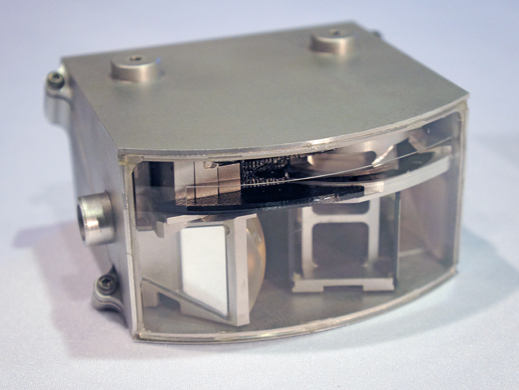Audi Shrinks the Autonomous Car
Audi has been testing self-driving vehicles on a stretch of Interstate 15 in Nevada, and in parking garages in Las Vegas, the company announced at the Consumer Electronics Show today.

The company also showed off a compact laser scanner for autonomous vehicles that is small enough to fit into the grill of a car. Laser scanners make it possible for autonomous vehicles to sense their surroundings, but driverless cars typically sport large, roof-mounted scanners.
“It’s no longer a matter of showing a car can pilot from A to B—we know we can do that,” said Ricky Hudi, head of development electrics and electronics at Audi. “All these cars have towering sensors on the roof and the luggage compartment is full with computers. We need to work out how to embed this technology into the vehicle.”
Audi’s fist-sized laser scanner is designed to scan ahead and to the sides of a vehicle, said Hudi, and is cheaper than the roof-mounted scanners seen on top of autonomous cars such as the one developed by Google. Hudi also showed a prototype circuit board intended to take over the job of the computers that take up space inside Audi’s current research vehicle. “All the systems you see in the trunk today will be replaced by that.”
Audi has been carrying out its driverless car research using the first-ever license issued by the Nevada DMV under a law that took effect last year allowing the licensing of autonomous cars.
Like other manufacturers, Audi has already put some autonomous driving technology in its cars. Premium Audi models can steer themselves back into the lane if the driver strays and can automatically control the throttle, brakes, and steering to follow traffic.
Hudi signaled that these technologies would evolve into a system capable of taking the wheel completely for trips through a busy city, for example.
Audi shied away from using the term “driverless” or “autonomous” when talking about future cars. “We speak of piloted driving because, like with a plane, the ultimate responsibility rests with the pilot, the driver,” said Hudi.
That stance is even bolder than the one taken by Toyota, which yesterday showed an autonomous research vehicle at CES but pledged to have humans in control at all times (see “Toyota Unveils an Autonomous Car, but Says It’ll Keep Drivers in Control”).
Hudi and other Audi executives demurred when asked when the compact automation sensors and computing systems they showed might appear in commercial vehicles, citing the vagaries of technology development and unclear regulatory environment in the U.S. and elsewhere.
However, Wolfgang Dürheimer, who is in charge of Audi’s R&D efforts, said that he believed Japan would be the place to get it first. “We think this will be one of the markets where this comes to market quickest,” he said. “The traffic and parking situation in Japan is quite outstanding.”
There and elsewhere, large cities would be the place autonomous vehicles appeared first, Dürheimer said, allowing people to have their car drive off and park itself.
Keep Reading
Most Popular
Large language models can do jaw-dropping things. But nobody knows exactly why.
And that's a problem. Figuring it out is one of the biggest scientific puzzles of our time and a crucial step towards controlling more powerful future models.
How scientists traced a mysterious covid case back to six toilets
When wastewater surveillance turns into a hunt for a single infected individual, the ethics get tricky.
The problem with plug-in hybrids? Their drivers.
Plug-in hybrids are often sold as a transition to EVs, but new data from Europe shows we’re still underestimating the emissions they produce.
Stay connected
Get the latest updates from
MIT Technology Review
Discover special offers, top stories, upcoming events, and more.